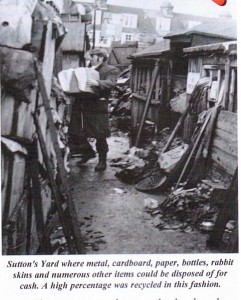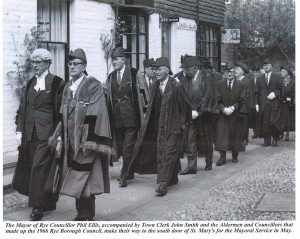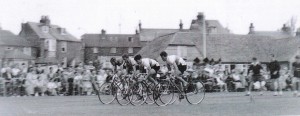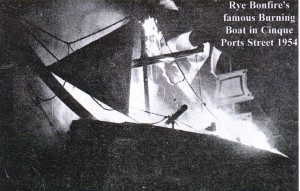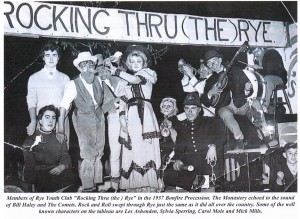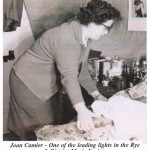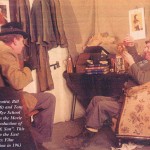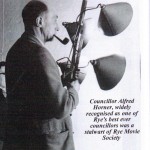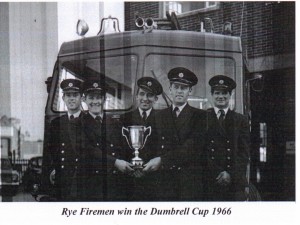By Jim Hollands
If you were one of those that lived in Rye during the 1950’s and 60’s you will remember many of the faces of those appearing in this feature.
It was a time when money was just becoming available in working families to buy televisions, washing machines and other electrical time saving gadgets for the home. Hire purchase was introduced but the first third of the money for anything bought this way was needed to secure a contract.
Many families were able to purchase their first home, in 1960 a house in Eagle Road or South Undercliff could be had for just over £1,000 and good old Rye Building Society was there to advise and loan the money, as long as the monthly payments did not exceed 25% of income.
In 1966 a new Police Station was built, replacing the antiquated building in Church Square. No less than forty nine bobbies were stationed at Rye, covering the town and adjacent villages. Each village had a police house where a local PC lived. He took his orders from Rye but was nearly always available on his own patch to help with problems ranging from ‘scrumping’ to major crime.
Rye even had its own C.I.D. section and round the clock uniformed police patrols, the Police Station itself was open day and night. There were cells at the station to hold miscreants until they were called before the Magistrates Court at Rye Town Hall. Crime was not a major problem in those days because most criminals were caught, it was a fine deterrent. Contrast this with what is happening today. The Magistrates Court is now at Hastings, the cells at Rye are filled up with bikes and the Police Station itself is closed during the hours it is most needed, PCSO’s are now required to do the job of the old style policeman. Fortunately Rye has had good PCSO’s, especially Dan Bevan, whose efforts in the team over the last four years have seen crime reduced in the town.
In the 60’s we recycled our rubbish at Sutton’s Yard Winchelsea Road. Most Rye youngsters used this amazing place to supplement their pocket money. Waste Paper, cardboard, bottles, metals, even rabbit skins were purchased here for cash. A high percentage was recycled in this fashion.
In those far off times Rye had its own Borough Council. Planning and fiscal decisions were taken at Rye Town Hall by Councillors well known in the town. The streets were kept spotlessly clean by a couple of men using push along carts with shovel and brush. Dustbins were collected from the back door by a cheerful gang of lads using the town’s own dust cart, the contents being disposed of on the Camber fields, raising ground which has now become a sea defence asset. Of course we had no plastic wrapping and milk bottles were made of glass which were used again and again. The supermarkets introduced large scale plastic wrapping and bottles.
In those days life was slower, cars were slower, many pre-war vehicles were still in use, some with a top speed of 30 mph! The groceries were ordered in a little red book which usually arrived at the shop in the hands of a junior member of the family, with the book came the cash for last week’s order. The grocer got the order up in a cardboard box (more recycling) and it was delivered that same evening by the grocer’s delivery vehicle, a youngster of school age on a special push bike with a huge basket on the front with drop down legs to support the load when stopped. As many as ten boxes could be carried, there were no health and safety officers then but I did a delivery round for a long period and never came to grief, nor do I remember any of the other delivery lads having any problems. Imagine the supermarkets of today giving a service like this with a week’s free credit.
The shopkeepers of those times supported and assisted the community in the same way as our small shopkeepers do today but there was a big difference then. Law insisted that ‘retail price maintenance was strictly adhered to. This meant a bag of sugar in one shop would be the same as in any other shop in the kingdom. This ensured two things, first that a good shopkeeper earned a fair living for his many hours work, secondly it made it possible for customers to buy all groceries from the shop of their choice. In practice most people picked a business where they got good service and were loyal to local traders. Why go to Hastings to get a television when it was available from three or four outlets in Rye at the same price? It kept small towns prosperous and unwittingly kept environmental dangers and pollution to a minimum.
When the large chain stores claimed they would reduce prices if R.P.M. was abolished a free vote in Parliament carried the day by one vote. It was from that day the fate of small food shops and many other trades were doomed and it was from that same day that the mountains of plastic waste began to be seen. What about all the savings from the fantastic price reductions? I suppose if a person spent hours of their time seeking the shop with the cheapest sugar, tea, etc. etc. a few shillings (Oh dear! I mean Pounds and New Pence or am I too late and we are changing to Euros?) But what about time and cost of fuel and wear and tear etc.? Never mind, back to the 1960’s.
The Monastery echoed to the sound of Bill Haley and The Comets. Rock and Roll swept through Rye just the same as it did all over the country.
Carnaby Street in London became the world centre of fashion. Thousands flocked to the tiny street off Regent Street where more amazing and bizarre happenings were taking place every day. There were girls serving behind the counters in ‘topless’ dresses, The craze caught on in London and there were photographs in the popular press of young ladies strolling past Nelson’s Column wearing little more than a ‘pelmet’.
‘Topless’ dresses were not seen in Rye but the mini skirt certainly was. Those that lived through the 60’s in Rye will remember it as a time of fantastic colours, very pretty girls and music that was so good there has been little to challenge it since.
Frank Clarke, the barber, headed up the Rye Sports Day Committee. They put on a festival of foot and cycle races on the Cricket Salts every August bank Holiday Monday.
There was a Rye Athletic Club in the 50’s, run by school teacher Les Fulluck. Unfortunately, when he left Rye to teach in the Isle of Weight, the club was disbanded. This left the odd unattached individual from Rye to compete against the best that the clubs from all over the country could put out at Rye.
The local crowd of up to 2,000 attending the sports meeting would shout for anyone from Rye so the Rye Wheelers became the crowd pleasers. In 1964,65 & 66, led by Mike Ashdown, one of the best short distance track riders in the country, the Wheelers won the famous Gasson Team Shield for three years in succession.
The Beatles came on the scene at a time I ran a Camera & Record Shop in Cinque Ports Street. Some readers may remember Heather Bottomley who ran the record department. In one week we sold ten times as many Beatles ‘Revolver’ LPs as we had ever sold singles of any other artist, even Elvis himself. It was a wonderful time to be young. A new age was dawning. Ballrooms seemed to change into Dance Halls almost overnight. Young people were screaming for more noise and action. The Monastery shook to the sound of Rock & Roll.
Bonfire Night was at a pinnacle of popularity at the time, personalities of television, stage and screen were chaired on the famous seat to light the bonfire. There was a fantastic Dragon that breathed flames two feet long and a burning boat, dragged on a trailer around the streets. For the hungry ones the Bloater Boat came with the procession and provided a never to be forgotten roadside fish feed (Mind the bones).
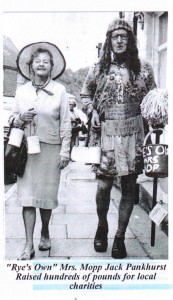 Another annual event to look forward to was Rye Carnival, latterly held in conjunction with Sports Day. Rye Firemen were prominent again, setting up a large canvas water container and grabbing young ladies and suited gents from the crowd and unceremoniously throwing them in the tub.
Another annual event to look forward to was Rye Carnival, latterly held in conjunction with Sports Day. Rye Firemen were prominent again, setting up a large canvas water container and grabbing young ladies and suited gents from the crowd and unceremoniously throwing them in the tub.
There was also an event which would cause a public outcry if it were repeated today. A “Greasy Pig” was released and anyone catching him became the owner. The pig ran squealing around the Cricket Salts and after numerous attempts that left the thwarted catcher empty handed and covered in grease a triumphant chaser would hold on to the, by now, much less greasy animal and claim his prize. When I tell this story these days I get exclamations of disgust, but the reader must remember a World War where the most unmentionable atrocities had been witnessed was still strong in the memories and farm animals were looked on as food rather than pets.
Dances at the Drill Hall The Monastery and Hastings Pier, for those that had transport and two nights fun at Rye Youth Club run by Peter Mitchell at the F.E. Centre made up a young persons social programme but most were also involved in sporting events. There were many local football teams in and around Rye. By 1968, two years after England won the World Cup, Rye United had three teams, Rye Athletic had two; East Guildeford one; Iden two; Udimore two; Peasmarsh one; Northiam three; Beckley one; Brede one; and Icklesham three.
In other sports Rye Cricket Club ran two teams, there was a Hockey Team and a thriving Cycling Club. Tennis and Golf were also available to young and old alike.
For those of all ages who wanted to be creative Rye Movie Society or Rye Players were the organisation to be in. The ‘cine club’ as it was affectionately dubbed, met weekly at the Further Education Centre and was successful three years running in winning the East Sussex Film Competition. Actors and production staff were made up from all walks of life. School teachers, Councillors and other dignitaries and local personalities worked together on production and acting.
Those Ryers that were not yet born by the 60’s, will never have experienced the fun of living in an era of exciting change at a time in history when there were few wars and justice was done and seen to be done. The freedom, fought so hard and long for in the 40’s meant just that. Winston Churchill had cut the red tape into shreds. Politicians and Councillors were respected.
It was not to last. The 70’s heralded the abolition of retail price maintenance, entry into the ‘common market’ and ‘hippies’ who introduced drugs on a large scale. Comprehensive schools brought relaxation of discipline. The Rye Magistrates Court was abolished, local crime increased at about the same rate as the police were moved from Rye to Hastings. By 1990 Rye was but a shadow of its former self and worse things still were just around the corner. Health & Safety became a pet project for the European Economic Community in the new millennium and soon the repercussions were being felt in Rye. Dozens of headstones were pushed over in Rye Cemetery by Rother District Council staff, Rye Bonfire and other public events were threatened with extinction by new directives and hiked up insurance. Rye’s dazzling cross Street Christmas lights were extinguished. Public conveniences were threatened with closure by Rother, there was even talk of selling off the Police Station!
Looking back over my lifetime I can easily pick the 50’s and 60’s as the best time to have lived in this Ancient Town, Looking back it is easy to see where it all went wrong. The only service today that compares with that of the 60’s is Rye’s Fire Service. They are the only force not to have been centralised and they are the only ones who can be relied upon to respond as quickly today as they did in 1960. There is a lesson to be learned here. Churchill once said that those that forget history do so at their own peril. History shows that Rye was better run, cleaner and a nicer place to live when it was controlled by it’s own Borough Council. Emergency services were much quicker when centred on Rye.
The sixties were good so why not get back as far as possible towards them? Sometimes going back is the only way of going forward.
There will never be a Rye Borough Council again, but splitting Rother into three sections is quite possible (26% of Borough, District and Municipal Councils have already gone down this road). If Rye, Battle and Winchelsea Town Councils along with the Parish Councils and Bexhill Forum push Rother District Council hard enough they will have no choice. This would mean that the Rye Area Committee would sit in Rye Town Hall. Rye District Councillors and the eight District Councillors representing the surrounding villages would make decisions on Planning and Finances in the Rye Area.
This would all take place under the scrutiny of Rye and other local Councillors and anyone from the public who wished to attend and comment on the issues of the day, sensible decisions would not only be made, they would be seen to be made as happened in the ‘sixties’.
Joan Camier – One of the leading lights in the Rye & District Movie Society
“Rye’s Own” February 2009
All articles, photographs and drawings on this web site are World Copyright Protected. No reproduction for publication without prior arrangement. © World Copyright 2015 Cinque Ports Magazines Rye Ltd., Guinea Hall Lodge Sellindge TN25 6EG


